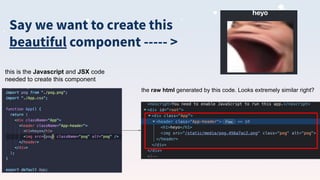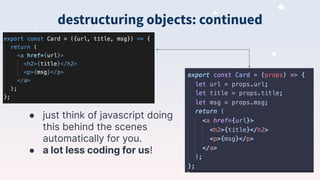Full Stack React Workshop [CSSC x GDSC]
- 1. React Fundamentals In addition to some full-stack development!
- 2. $whoami > Jarrod Servilla > CSSC Tech Director > Daniel Laufer > GDSC Workshop lead > Milind Vishnoi > GDSC Workshop lead
- 3. What youʼll learn ● What is React? ● What is JSX? ● Creating reusable react components ● Dynamic rendering ● Component lifecycle ● React hooks & why we use them ● Full stack development fundamentals ● Networking protocol basics (http)
- 4. youʼll create your own full stack app! and most importantly... (kind of)
- 5. important resources source code: https://github.com/utm-cssc/full-stack-react-workshop gdsc workshops: https://github.com/Daniel-Laufer/GDSC-UTM-Workshops cssc site: https://cssc.utm.utoronto.ca/ if you’re coding along with us: ● an ide (vscode) ● node.js ● docker
- 6. What is React? ● a declarative, component-based front-end javascript library developed by Facebook ● enables developers to build modern, sleek, fast applications with a modular infrastructure ● react is by far the most popular front-end javascript library/framework!
- 7. Who uses React? And soooooooo many more!
- 8. Why should you use react? ● can organize parts of the UI into components that can be easily reused ● users can interact with the website without refreshing it ○ Ex. dynamically rendering search results from a search query ● you want to make use of its rich ecosystem and large community support ○ if you search “how do I do X with react”, odds are there will be many relevant search results ○ there are tons of react libraries for you to use. For example: react-spring allows you to add sophisticated, good-looking animations into your apps ○ users can share their own components with the community by creating packages
- 9. What are React Apps made of? ● Primary Javascript and JSX (a ‘syntax extension’ for Javascript). ○ Note that you can use plain Javascript to write React code but it’s much more difficult/messy ● JSX looks a lot like standard HTML Let’s take a look at an example!
- 10. Say we want to create this beautiful component ----- > this is the Javascript and JSX code needed to create this component the raw html generated by this code. Looks extremely similar right?
- 12. Components A React component is a JavaScript function that optionally takes in inputs (props) and returns ONE JSX element (this one element can have many children). our simple TodoItem component Using our component and passing data (props) into it * you can also create components using classes but we won’t discuss that in this workshop :)
- 13. Using components components can be rendered in two ways: with and without children. return ( <Navbar /> <PageWrapper> <Navbar /> </PageWrapper> ); Here Navbar is a child of PageWrapper
- 14. Using components ● You can continue nesting components as much you’d like! ● For example... <PageWrapper> <Navbar /> <div> <PageWrapper> <Navbar /> <Navbar /> <Navbar /> </PageWrapper> </div> </PageWrapper>
- 15. JavaScript inside JSX components you may have seen us wrap some portions of code in curly braces i.e {...}. Why is that? ● here everything outside the ‘{..}’ is JSX, and everything inside is javascript. ● if we didn’t have the curly branches there, our javascript code would be interpreted as a string and NOT code (ie “messages.reduce((prev, curr) ⇒ prev.concat(curr), "")”)
- 16. Before we get into coding, letʼs take a look at some interesting JavaScript syntax you will see Jarrod use
- 17. two ways of writing functions in Javascript think of these as being equivalent function definitions for this workshop. (There are some more technical differences between these two functions but don’t worry about them for now 😉)
- 18. using components: destructuring objects here is a component that takes in multiple props. the { … } is called object destructuring, which pulls out the values from the props object and exposes it to us as url, title, and msg respectively.
- 19. ● just think of javascript doing this behind the scenes automatically for you. ● a lot less coding for us! destructuring objects: continued
- 20. Time to Code!
- 21. Dynamic rendering how do we render based on input?
- 22. Dynamic rendering Suppose you wanted to create a component like this that contains an arbitrary amount of children one of the strengths of react is that we can use javascript to render React elements dynamically!
- 23. instead of doing this….
- 24. … do this! It’s basically just a fancy for loop that generates a list of react elements!
- 25. Time to Code!
- 26. lifecycle + hooks updating the view after modifications occur
- 27. component lifecycle 🌱 mounting: component initialization, and addition to dom 🔄 updating: when props/state of a component changes, rerender! ⚰ unmount: cleanup component resources, remove from dom
- 28. hooks Hooks was introduced in React 16.8 Hooks let you use state and other React features without writing a class.
- 29. why hooks? ● no one knows how “this” works. ● organizing our components by lifecycle methods forces us to sprinkle related logic throughout our components. ● Makes testing easier
- 30. useState this react hook allows us to persist data across re-renders (and forces a re-render when our state changes) in that state! In the example function you can create a count state for the component using useState as shown. You can use count to access count within the component.
- 31. useEffect this react hook allows us to run code (fetching data, updating state) when changes occur in the states specified.
- 32. useEffect as componentDidMount We can use ‘useEffect’ to implement ‘componentDidMount’ function.
- 33. useEffect as componentWillUnmount We can use ‘useEffect’ to implement ‘componentWillUnmount’ function.
- 34. create custom hooks When we need to use function logic in more than one component we can extract that logic into another function (hook). A custom hook is a JavaScript function whose name starts with ”use” and that may call other hooks. for example: using a custom hook to fetch data for different URL.
- 35. creating custom hooks Custom hook Using the custom hook
- 36. Time to Code!
- 37. full stack apps how do we persist data?
- 39. API: Application Programming Interface createTodo(message) deleteTodo(todoid) editTodo(todoid, message, ...)
- 40. URL: Universal Resource Locator /todos /todos/<id> /todos?todoid=<id> /todos?maxPages=<num> https://my-domain.api.com
- 41. HTTP: Hypertext Transfer Protocol /todos/<id> [GET] /todos/<id> [DEL] /todos?todoid=<id> [GET] /todos?maxPages=<num> https://my-domain.api.com
- 42. 200 OK: The response has succeeded! 201 Created: The request has succeeded, and the resource has been created (usually for POST) 400 Bad Request: The server could not understand the request due to invalid syntax 401 Unauthorized: The client is not allowed to get the requested response 404 Not Found: The server cannot find the requested resource 418 Iʼm a teapot: The server refuses to brew coffee because it is, permanently, a teapot. 500 Internal Server Error: The server has encountered an issue while processing your request after issuing an http request, we expect to receive a status code and response body (typically JSON). http statuses describe what the server did in response to the request.
- 43. api integration connecting our frontend to our backend
- 44. Time to Code!











![Full Stack React Workshop [CSSC x GDSC]](https://image.slidesharecdn.com/fullstackreactworkshopcsscxgdsc-230221003415-b512c1cf/85/Full-Stack-React-Workshop-CSSC-x-GDSC-11-320.jpg)





























![HTTP: Hypertext Transfer Protocol
/todos/<id> [GET]
/todos/<id> [DEL]
/todos?todoid=<id> [GET]
/todos?maxPages=<num>
https://my-domain.api.com](https://image.slidesharecdn.com/fullstackreactworkshopcsscxgdsc-230221003415-b512c1cf/85/Full-Stack-React-Workshop-CSSC-x-GDSC-41-320.jpg)



